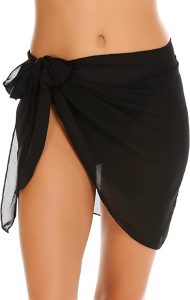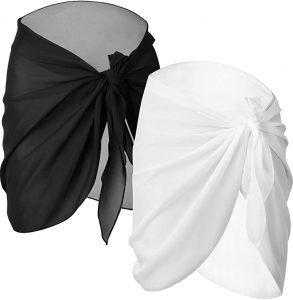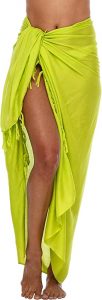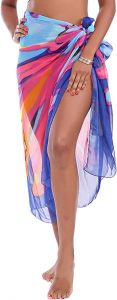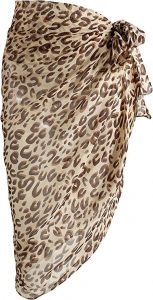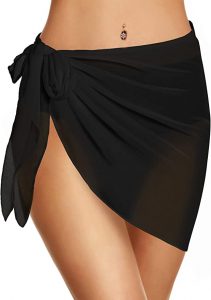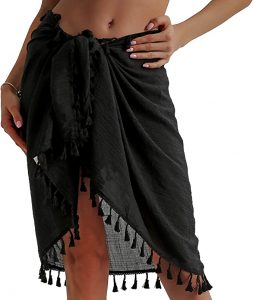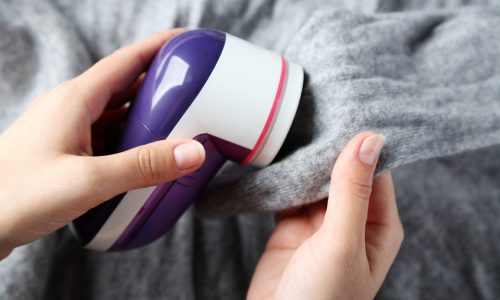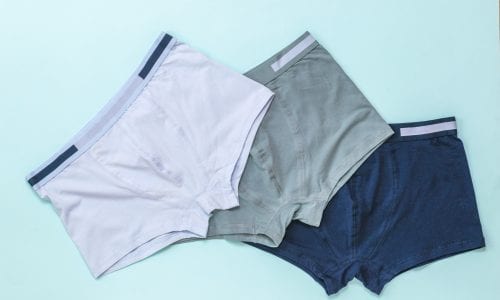The Best Sarong

Our Review Process
Don't Waste Your Money is focused on helping you make the best purchasing decision. Our team of experts spends hundreds of hours analyzing, testing, and researching products so you don't have to. Learn more.
Our Picks For The Top Sarongs
- 1. Ekouaer Machine Washable Chiffon Sarong
- 2. Chuangdi Lightweight Adjustable Slit Sarongs, 2-Count
- 3. SHU-SHI Fast-Drying Rayon Fringe Sarong
- 4. MissShorthair Breathable Polyester Sarong
- 5. CHIC DIARY Extra Tie Length Chiffon Sarong
- 6. CHICGAL Lightweight Polyester Sarong
- 7. Eicolorte Tassel Pareo Style Sarong
This sheer black sarong is a wonderful choice for your next trip to the beach or pool. It is made of 100% polyester for easy care in your washing machine and it ties at the side for a beautiful look and full coverage.
Classic SophisticationLook chic on the beach with this solid-color sarong that is amply sized to cover you.
You'll always have a cover-up at the ready with this two-pack of sarongs. They measure 55.1-by-19.6 inches, so they will fit most people well. They tie in the front and the set has one each in black and white to easily match any swimsuit.
Dries QuicklyThis sarong dries quickly and serves as a beautiful accessory for your next beach trip.
This rayon sarong will gracefully drape down most of the length of your leg if you tie it at the waist. You can also wrap it around your shoulders or wear it as a strapless dress. It accentuates your curves and features plenty of tassels, lending additional style to your beach or poolside look.
Graceful LooksWith many ways to wear it, this sarong is an excellent addition to your beach bag.
Add some style to your beach look with this lightweight polyester sarong. It has swirls of pink, orange, blue, purple and more, so it's sure to match any swimsuit. It floats gently with your every movement, making it both attractive and comfortable.
Sheer and MulticoloredEffortlessly cover yourself when you get out of the water with this fashionable sarong.
Buying Guide
A sarong is a long piece of cloth that is wrapped around the body. It is usually made from a light, airy fabric such as cotton or linen and can be decorated with patterns or embroidery. However, they can also be made from heavier fabrics such as silk. Sarongs are traditionally worn by women in Southeast Asia and the Indian subcontinent, but they are becoming increasingly popular as beachwear in Western countries.
When choosing a sarong, it is important to consider the climate and activities that you will be participating in while wearing it. For example, if you are planning to wear it at the beach, you will need a sarong made from a light, breathable fabric that can withstand salt water and sand. This will also ensure it will dry quickly. If you are wearing your sarong in a more formal setting, such as a wedding or religious ceremony, you may want to choose one made from a more luxurious fabric such as silk.
There are many different ways to wear a sarong. The most common way is to wrap it around the waist and tie it in front. This can be done with the sarong hanging loose or pulled tight. Other ways to wear a sarong include wrapping it around the chest or shoulders, or even wearing it as a headscarf.
When wearing a sarong, it is important to remember that the fabric is usually transparent. As such, you may want to wear a slip or underskirt underneath if you are concerned about modesty. Sarongs can be found in a variety of colors and patterns, so you should have no trouble finding one that suits your taste.
What to Look For
- When shopping for a sarong, make sure you pay attention to the sizing. Some sarongs have sizes like small, medium or large. These may be tied to pants sizes or may just have measurements. Other sarongs just have measurements listed.
- Check yourself with a tape measure before ordering to be sure the sarong will give you the coverage you want.
- Many sarongs are sheer, so you shouldn’t rely on them to cover your swimsuit to the extent that it isn’t visible. Instead, they just offer a fashionable bit of light coverage.
- Sarongs do not usually include any type of sun protection factor, so you’ll want to wear sunscreen when you’re enjoying the beach or pool.
More to Explore
Sarongs go back centuries in Pacific island cultures and on the Malay Peninsula. They didn’t become popular in the continental United States until the last 100 years, largely thanks to their appearance in movies.
Early Hollywood star Dorothy Lamour is credited with helping bring them into the American mainstream in the 1930s because of her numerous onscreen roles that included sarongs as a costume.

